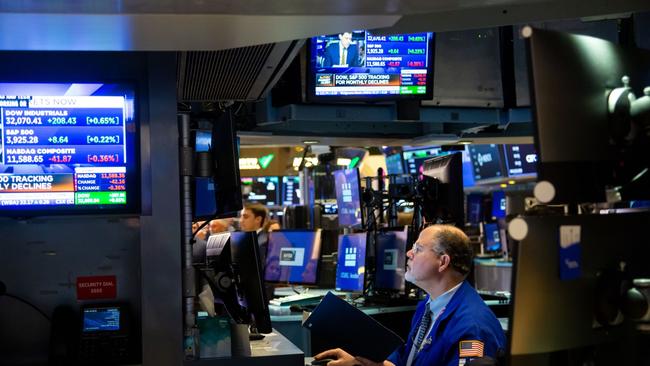Strong US data increases jitters over more rate rises
Just when investors think US financial conditions are tight enough to avoid more rate rises by the Federal Reserve, key US economic data has overshot expectations.

Business
Don't miss out on the headlines from Business. Followed categories will be added to My News.
Global sharemarkets aren’t out of the woods despite a nascent rebound.
Just when investors began to think it was safe enough to wade back into the market because the economy had cooled enough to bring an end to rate hikes, new US retail sales and industrial production data overshot expectations signalling the Fed’s work is not done.
The data reignited jitters about inflation and interest rates, pushing the global benchmark 10-year US Treasury bond yield up 14 basis points to a fresh 16-year high of 4.84 per cent. At the same time, the policy sensitive two-year Treasury bond yield hit a 16-year high of 5.21 per cent.
The renewed upward pressure on bond yields at least temporarily capped a rebound in the S&P 500 despite this week’s optimism over diplomatic efforts to contain the Middle East crisis.
Australia’s S&P/ASX 200 share index rose 0.3 per cent to 7068.5 points on Wednesday after China’s latest economic data came in better than expected.
The Australian dollar rose 0.4 per cent to a four-day high of US63.88c.
A US recession is still considered likely. The Fed’s recession probability model based on the Treasury spread as of September, predicted a 56 per cent chance of recession 12 months ahead. But after such a rapid and massive tightening of US monetary policy over the past 20 months, the US economy hasn’t slowed enough to ensure underlying inflation returns to target levels.
Citi’s US Economic Surprise Index shows US data has mostly beaten expectations this year.
With the Atlanta Fed’s September quarter GDP “nowcast” now running at a cracking pace of 5.4 per cent annualised, the concerted “dovish pivot” from Fed officials in the past week seems moot.
Still, Richmond Fed President Tom Barkin noted Tuesday that there was a “disconnect” between the strength of the economic data and what he’s hearing from businesses in his district.
“I see an economy that is much further along the path to demand normalisation than much of the data would tell you,” he said.
It comes after the widely followed University of Michigan Consumer Sentiment Index fell by the largest month-over-month decline since June of 2022. Of particular note was the decline in consumers’ assessment of personal finances, which fell by 15 per cent in the most recent reading.
“The rise in geopolitical tensions could weigh further on consumer and corporate confidence,” said Morgan Stanley US chief equity strategist and chief investment officer Michael Wilson.
Investors have started to anticipate the usual December quarter rally in shares.
But the strength of the US economy is a double-edged sword at this point in the cycle.
Corporate earnings may be stronger than expected, but the Fed may have more work to do on interest rates, potentially lifting the yield on “safe” bonds above the earnings yield offered by “risky” investments like shares. The overall strong economic data flow is increasing the risk of a Fed policy “mistake”.
Combined with the Middle East crisis, it seems inconsistent with below-average volatility in shares.
Reflecting such concerns, JPMorgan added to government bonds and gold in its model portfolio. Despite the tentative rebound in global shares this month, the US bank remains negative on the medium-term outlook as “headwinds are getting stronger and tailwinds weaker”.
Equity valuations are “still rich” and sharemarkets face an increasing risk of derating due to high real interest rates and the cost of capital, while earnings expectations for next year appear “overly optimistic”, according to the US bank’s chief global market strategist, Marko Kolanovic.
He said the quarterly reporting period in the US was likely to show negative earnings growth based on weakening PMI momentum, while softening corporate pricing could lead to a “squeeze on margins”.
“Lags in the impact of high rates are longer this time, but we believe most of the negative effects are still to come,” Dr Kolanovic said. “Delinquencies in consumer loans and corporate bankruptcies are starting to move higher, and this trend is likely to continue absent a cut in rates.”
The flare-up of geopolitical risk in the Middle East “adds another headwind and increases tail risks for markets and economic activity”. Dr Kolanovic recommends caution while interest rates are “deeply restrictive, valuations expensive, and the overhang of geopolitical risks persists”.
“Given the above, we maintain a defensive allocation in our model portfolio, with an underweight in equities and credit versus overweights in cash and commodities,” he said.
While he noted that it “remains uncertain whether bonds have bottomed” in price, JPMorgan recently reversed last month’s well-timed cut to his model portfolio’s duration exposure.
The US bank added 1 per cent to its government bond allocation in its model global asset allocation portfolio, due to geopolitical risk, cheap valuations and less pronounced positioning.
JPMorgan also increased its commodities allocation to gold, both as a geopolitical hedge, and given an expected retracement in real bond yields.
Originally published as Strong US data increases jitters over more rate rises



